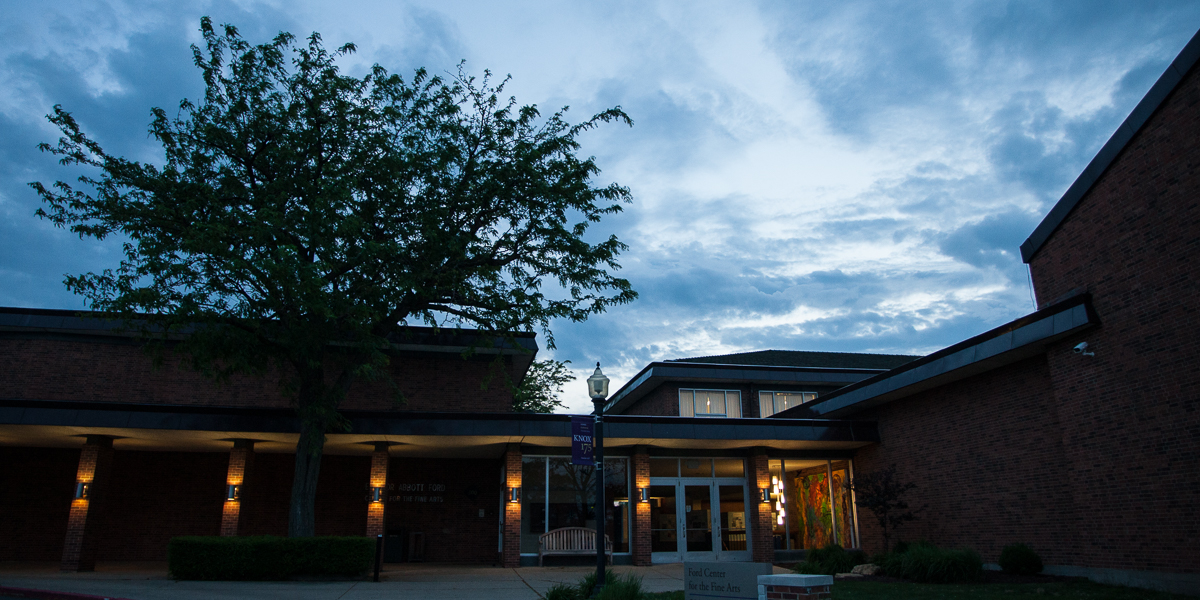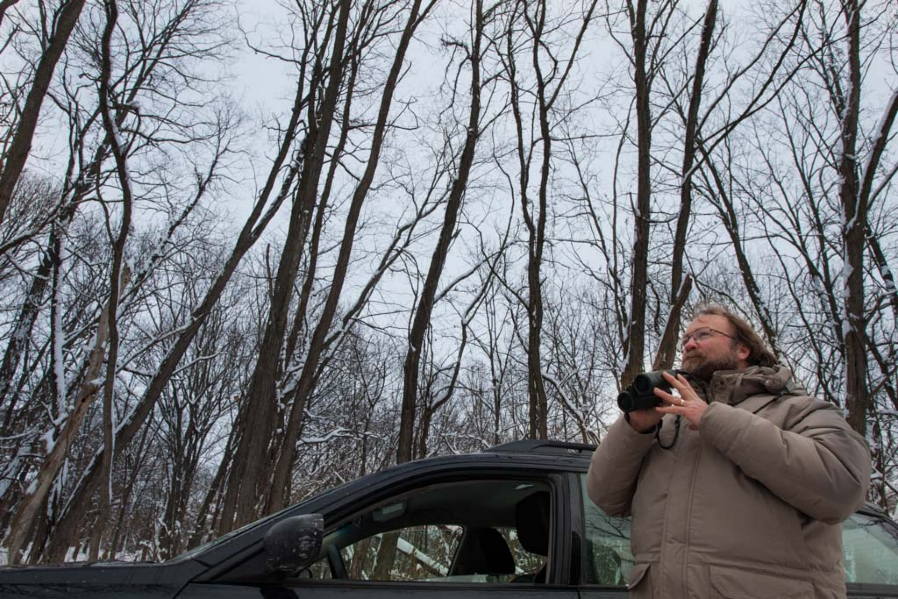Knox Stories
Knox “Abolition for All Time” Lab Excels in Second Year
A major focus of the second year was curricular innovation.

Office of Communications
2 East South Street
Galesburg, IL 61401


Above: Knox College biologist James Mountjoy during the Audubon Christmas Bird Count. More photos in gallery below
With overcast skies and temperatures well below freezing, traipsing about rural Knox County scanning the skies for birds and jotting down numbers on paper represent a labor of love and dedication to science for three biologists at Knox College -- James Mountjoy, associate professor of biology; Stuart Allison, professor of biology; and Paul Skrade, interim sustainability coordinator, as they took part this month in the Audubon Society's 114th Annual Christmas Bird Count.
Mountjoy, Allison and Skrade covered a wide range of sites within a 15 mile circle in east-central Knox County, including Knox's Greek Oaks biology field station, the Oak Run area, Victoria, Oneida and open farm country on December 15.
Mountjoy, who has published numerous research articles on his bird research, has been participating in the local Christmas Bird Count since 2002. This year's data from Knox County -- 70 species identified and an estimated 11,000 individual birds counted -- are forwarded to the Audubon Society, which has led the Christmas Bird Count for 114 seasons. Last year there were 2,248 counts in the United States, Canada, and Latin America and the Pacific Islands, with over 63,000 people participating.
Mountjoy, Allison and Skrade talk about their experiences this year:
 James Mountjoy: "The Christmas Bird Count is conducted within a 15 mile diameter circle in the eastern part of the county, and it covers Green Oaks, the Oak Run area, Victoria, Oneida and large chunks of open farm country. We have been running this particular count for 12 years, since 2002, but the Christmas Bird Count has been running for 114 seasons. Last year there were 2,248 counts in the United States, Canada, and Latin America and the Pacific Islands, with over 63,000 people participating.
James Mountjoy: "The Christmas Bird Count is conducted within a 15 mile diameter circle in the eastern part of the county, and it covers Green Oaks, the Oak Run area, Victoria, Oneida and large chunks of open farm country. We have been running this particular count for 12 years, since 2002, but the Christmas Bird Count has been running for 114 seasons. Last year there were 2,248 counts in the United States, Canada, and Latin America and the Pacific Islands, with over 63,000 people participating.
The combined species list was 70, and about 11,400 individual birds were counted. This was a fairly average number of species for our count (our record is 80 species). Three species made up more than half of all of the birds counted: European Starling (2,658), Canada Goose (2,238) and Red-winged Blackbird (1,368).
The best bird of the count was undoubtedly the Loggerhead Shrike discovered on Friday by Mike Baum while 'scouting' for the count. This is an endangered species in Illinois, and they normally winter farther south than Knox County, so it is not surprising that this was a first record for our count. Other unusual species included Trumpeter Swans, Hermit Thrushes and a Yellow-bellied Sapsucker.
We had 11 participants and the earliest was out in the field by 4:30 am, and the latest was out past 5 pm (by which time it was already dark). We did have a diversity of participants, but the Knox count was probably a bit unusual in having five observers with PhDs in Biology.
Stuart Allison: "  ...I was working in the area northeast of Victoria with Jeff Walk, a biologist from the Nature Conservancy. Jeff and I saw a red-shouldered hawk, which is unusual for this part of the country in winter and we had the only one sighted yesterday. The way it flew and entered some woods rather low in the trees suggested red-shouldered behavior. Jeff has seen enough in various attitudes of flight that he was confident in the ID.
...I was working in the area northeast of Victoria with Jeff Walk, a biologist from the Nature Conservancy. Jeff and I saw a red-shouldered hawk, which is unusual for this part of the country in winter and we had the only one sighted yesterday. The way it flew and entered some woods rather low in the trees suggested red-shouldered behavior. Jeff has seen enough in various attitudes of flight that he was confident in the ID.
Another highlight was we ran into another member of the Christmas bird count, Mike Baum, a local bird expert and resident of Oak Run, who had spotted a loggerhead shrike. By this time of year loggerhead shrikes should be much further south than Knox County. I was excited because for me shrikes are "jinx birds" -- the ones you want to see but keep missing. I have been places where someone will say, "Oh, there is a nice shrike sitting on an osage orange tree about a quarter-mile down the road." I hurry off, and the osage orange tree is there, but no bird of any kind to be seen. So I really wanted to see the shrike. Jeff and I hurried down to the place Mike described, and after about 5 minutes of looking around found it and had a great view of the bird. A lifer for me - the first time I have seen a loggerhead shrike! Things like that make standing around in the biting cold worthwhile.
Paul Skrade: " ...This was a really fun Christmas Bird Count. I especially enjoyed hiking in Green Oaks with Dr. Mountjoy. It's a beautiful place and I haven't gotten to spend a lot of time out there. But even trudging through the snow in the cold you can appreciate what a jewel it is. It didn't hurt that we had tons (in my opinion) of Red-headed Woodpeckers - stunning in their stark contrasting red, black, and white.
...This was a really fun Christmas Bird Count. I especially enjoyed hiking in Green Oaks with Dr. Mountjoy. It's a beautiful place and I haven't gotten to spend a lot of time out there. But even trudging through the snow in the cold you can appreciate what a jewel it is. It didn't hurt that we had tons (in my opinion) of Red-headed Woodpeckers - stunning in their stark contrasting red, black, and white.
Another highlight was that between us, Dr. Mountjoy and I had FIVE different Eastern Screech-Owls in the count circle, which is a high number for that species in this area. We didn't see any of them but they respond by calling to playback of a recording.
I had another fun owl experience later when I was covering another part of the count circle. Pheasants Forever has an area east of Victoria that they have restored as a grassland for wildlife habitat, that looked like a perfect spot to find a Short-eared Owl, a grassland specialist that hunts at dusk. Unfortunately it is closed to the public without special permitting. However, I parked at the gate just at dusk and by standing on my seat I was able to get high enough to see the whole area. After about 15 minutes, I saw Short-eared Owls hunting over the grassland. Although it was nearly dark, their lighter feathers and distinct "moth-like" flight stood out clearly for the ID. Short-eared Owls are on the Illinois State Endangered Species list, and records like this are how we keep track of their population numbers.
What's really great about these counts though is that they involve the general public, not just professional scientists. If you can identify and count birds, you can participate. The folks I've counted with over the years include scientists, but I've also counted with students and teachers, bartenders, doctors, factory workers, computer programmers, lawyers, and lab technicians. Sure, folks like naturalists and biologists tend to already have that interest and you definitely see them on counts, but I'm always impressed by all of the other people who participate.
More photos with James Mountjoy, full-screen views, caption details and credits available in this set at the Knox College Flickr channel
Published on December 23, 2013